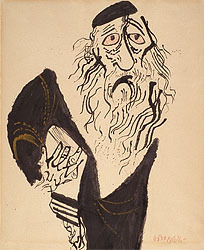FOCUS IN/ON - William Gropper
William Gropper: Early Life and Training

William Gropper, 1897-1977 The Wanderer, c. 1960 Ink with wash on paper, 16" x 14" Hillstrom Museum of Art, gift of Reverend Richard L. Hillstrom ('38)
William Gropper (1897-1977), according to his epitaph, was an artist "whose art was always on the side of man." This description aptly summarizes Gropper's attitude, and also indicates the environment in which he was raised. He was born in New York's Lower East Side, where Jewish immigrants were concentrated. His Gropper grandfather had come from Rumania to the area early, and his parents had very little. Gropper's father was an intellectual who had difficulty holding the menial jobs he found, and the family was supported largely through the efforts of Gropper's mother, who not only labored in a garment workshop but also took home piecework. The youthful Gropper himself worked to help the family, and among his early drawings are images of his mother hunched over a sewing machine at night and of himself as a boy hoisting a heavy barrel as part of his job helping deliver food to local saloons.
Gropper's formal education was sparse. He attended public school only until he was fourteen. He also spent some time in a Jewish heder, largely due to the influence of his grandfather, who exhorted Gropper's parents to raise him religiously (deemed a luxury by the parents). When the grandfather threatened to disinherit the family, they relented and young William began attending a Hebrew school with a stern rabbi who would pinch students when they erred in their lessons.
At an early age, Gropper showed an aptitude for draftsmanship (which was to remain the basis for his art throughout his career), and he received a medal for drawing during his elementary school years. Gropper would frequently sketch, on pads carried in his pockets and on the sidewalks and walls of his neighborhood. These sketches were noticed and led to Gropper being invited to study drawing at the Ferrer School, where he attended night classes from 1912-1915.
The school was a loosely run, very liberal institution named after executed Spanish anarchist and educator Francisco Ferrer (1859-1909). Students there encountered prominent, radical thinkers such as feminist Emma Goldman (1869-1940), a communist and co-founder of the Ferrer School, or Margaret Sanger (1879-1966), the much-maligned early advocate of birth control (whose own son attended the school). Artistic instruction at the Ferrer was quite unstructured, and students and artists of widely varying levels of competency, training, and professional development would work side by side, often sketching from a model and usually having informal discussions or critiques as part of the process. Painter Robert Henri (1865-1929), the leader of the "Ashcan School" that sought to embrace everyday, urban experience was, along with fellow Ashcan artist George Bellows (1882-1925), a principal art instructor at the Ferrer School, and both artists were very influential on Gropper.
In 1915 Gropper met Frank Alvah Parsons, head of the New York School of Fine and Applied Art, and he was offered a scholarship that led to two years of study there, during which he won numerous prizes. This, in turn, led to a job drawing for the New York Tribune, a conservative, anti-Communist publication. Gropper and a reporter from the Tribune were sent to investigate the Industrial Workers of the World (IWW), the socialist association known as the "Wobblies." Instead of submitting the expected critical coverage, Gropper and his colleague became sympathetic and involved themselves in publishing the IWW's paper, The Rebel Worker. Although Gropper worked anonymously as its cartoonist, his style was recognized and the Tribune fired him.